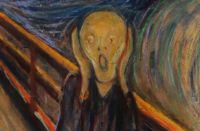Jonathan Glazer’s The Zone of Interest announces itself dramatically, with a blank screen and two minutes of foreboding music by Mica Levi heralding something ominous and important.
The film, loosely based on the Martin Amis novel of the same name, centres around the professional and family life of Rudolf Höss, commandant of the Auschwitz concentration camp, in which over a million people (overwhelmingly Jews, along with Poles, Roma, Soviet prisoners-of-war and others) were exterminated between 1941 and 1945. There is no grand narrative to speak of, nor are any of the crimes within Auschwitz visually depicted. The film is largely comprised of scenes from domestic life, in the Höss house on the other side of the Auschwitz camp wall, occasionally punctured or subtly encroached upon by a sense of the abject horror dwelling on the other side: the cries of prisoners, the terrible glow of its chimneys reflected in a window-pane, the smoke rising from a train pulling into the station, or even on one occasion, guards barking death sentences, overheard by the Höss children.
Glazer’s style is characteristically flat, muted and dignified. His players move through their clean, domestic world, with its spotless floors and manicured garden, almost mechanically, seemingly oblivious, though we suspect not entirely, to the scale of suffering being inflicted on the other side of the wall. If the film is horrifying in its own, polite way, it is also repetitious, and deliberately so.
Focusing on the bureaucratic, mundane aspects of the perpetration of the Holocaust — meetings with engineers to source a new incinerator system, meetings with fellow camp commandants to organise the logistics of transporting, putting to work and/or exterminating the Jews of newly-annexed Hungary, signing of paperwork, further meetings — suffices to paint an Arendtian portrait of the banality of evil, and the characters at its centre. Indeed, Glazer has stated his intention as precisely this, remarking in the New York Times: “I wanted to show that these were crimes committed by ‘Mr. and Mrs. Smith at No. 26’.” [1]
While there is some merit to identifying evil in the banal, it must be said that this also risks flattening any concept of evil to that of mere banality. Regrettably, it is for this latter reason that this somewhat contradictory (and frankly ahistorical) aphorism of Arendt’s — who, let us not forget, was an arch anti-communist and white supremacist who opposed the resistance of the National Liberation Front of Vietnam and the FLN in Algeria [2] — has become beloved in a western society characterised today, as any “Oscars” ceremony will attest to, by nothing so much as its unrecalcitrant evil and fondness for banality.
Although the invention of the concentration camp preceded Nazi Germany, originating in the “liberal” colonialism (of Germany, Britain, Spain and the United States, amongst others [3] of the turn of the 20th century, the scale and brutality of the Holocaust, in which approximately 12 million were killed, was only made possible by the rapid industrial and technological advances of the intervening years. In this sense, it was a crime of modernity, in which established colonial, white supremacist attitudes of the preceding hundred years were directed by an imperialist power against enemies on the European continent, assisted by the vast industrial development of the era.
In an intriguing filmmaking decision to which much of the studied flatness of its portrayal of family life is owed, Glazer set the Höss house up with ten hidden cameras running simultaneously, Big Brother-like, sometimes filming unbeknownst to his actors and “passively” capturing material for the film.
Contrastingly, hallucinatory, heat-vision scenes filmed in the dark — incidentally, filmed using military technology [4] — depict a girl hiding food for camp prisoners in the dirt of construction sites. Though its moral sensibility owes much to reactionary philosophy of the mid-20th century, Glazer’s film is very much a product of contemporary technology and aesthetics. But while it is as a result of the tension between these tendencies that Glazer might have his protagonists (and their director) disappear into insignificance, just normal people subject to the vicissitudes of history, the machines they use, the forms they have to fill out, there is something remaining within the frame awkwardly resisting this push.
Then comes the film’s climactic scene, in which Höss, descending flights of stairs, pauses to retch repeatedly, beset by some fleeting, unexplained fit of nausea: is it guilt for the untold suffering he has inflicted? Or, as he turns from left to right in the mid-distance, seeming to stare directly at the camera, the audience, is it something more profound? Glazer rapidly, tritely, cuts to the present day, with workers in the Auschwitz camp, now a memorial site and tourist attraction, sweeping up the long-since disused gas chambers and polishing the furnaces, and cuts back to Höss, who composes himself and descends the stairs again into darkness. This rapid shift to the present is a jarring artistic gesture which is all the more remarkable for its vagueness and lack of imagination, and seems a frankly trivial way to end a film which was, for all its shortcomings, a fascinating and technically impressive production.
The tension at the heart of The Zone of Interest thus remains unresolved, while the uneasy banality of Glazer’s vision reflects the inherent anxieties of a liberal historiography whose weltanschauung is pregnant with the very fascism it seeks to dehistoricise and domesticise. In this sense, it is very much a film about “now”.
1 Harvey, Giles (2023) “How Do You Make a Movie About the Holocaust?” New York Times website [https://www.nytimes.com/2023/12/19/magazine/movies-holocaust-zone-of-interest.html]
2 Arendt, Hannah, Chomsky, N. et al (1967) “The Legitimacy of Violence as a Political Act?” [https://chomsky.info/19671215/]
3 Pitzer, Andrea (2017) “Concentration Camps Existed Long Before Auschwitz”, Smithsonian Magazine website. [https://www.smithsonianmag.com/history/concentration-camps-existed-long-before-Auschwitz-180967049/
4 Canfield, David (2023) “A Deep Dive Into The Zone of Interest’s Chilling Presentation of Evil” Vanity Fair [https://www.vanityfair.com/hollywood/zone-of-interest-jonathan-glazer-shot-list-awards-insider]






